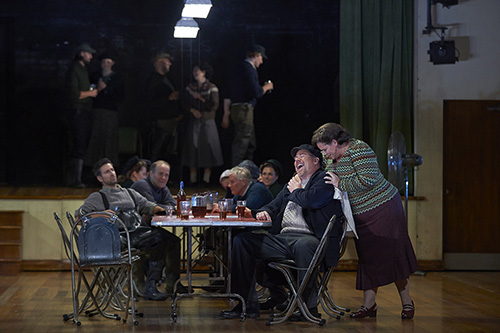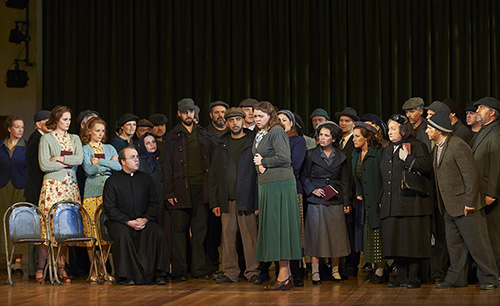-
The Mystery of Evil: Peter Grimes
By Danielle D'OrnellasPosted in Peter GrimesBy Nikita Gourski, Development Communications Officer, and Gianmarco Segato, Adult Programs Manager
Discover Benjamin Britten’s startling 1945 opera — Peter Grimes

In a sea-battered village on the east coast of England, a fisherman named Peter Grimes is suspected of murdering his young apprentice. But his crime – real or not – will soon be eclipsed by something more sinister: a nameless crowd united by hatred, out to persecute the lone outsider in their midst.
Finding Home, Away From Home
In April 1939, with fascism casting a long shadow over Europe, English composer Benjamin Britten relocated to America. While working in California, he discovered the poetry of George Crabbe, an English writer from the late 1700s. Crabbe’s bracingly realistic depictions of village life in Suffolk filled Britten with nostalgia and homesickness. And the story of a cruel Aldeburgh fisherman, included in Crabbe’s 1810 collection, The Borough, gave Britten the seed of his first full-scale opera. In reading Crabbe, Britten noted, “I suddenly realised where I belonged and what I lacked.” A year later, he and his partner, tenor Peter Pears, sailed home for England.The poet George Crabbe was born in Aldeburgh, while Britten was born only a few miles from there in Lowestoft. The geography and landscape of the coastal region underpins their best work.
Many scholars regard Peter Grimes as an allegory about social oppression. On this analysis, Grimes’s “criminality” is not inherent to his character but arises from internalizing the judgement of others, from assimilating a particular view of himself held by a hostile majority. Struggles with social censure were a part of Britten’s personal life too: he was a homosexual, which was considered a criminal offence in Britain at the time, and a committed pacifist, which he remained even at the height of the British war effort.

The "Borough"
The tightly knit, close-minded townspeople who shun Peter Grimes are played by the chorus, along with a number of supporting performers. The advance of the crowd on Grimes is one of the most menacing and chilling scenes in all opera. Aided by our impressive COC Chorus and Orchestra conducted by Johannes Debus, Armfield handles the scene with a simple and highly effective manipulation of the set, which focuses the terrifying experience of crowds and power, into an unforgettable moment of breathtaking theatre. In Act II, the men of the Borough go off to track down Grimes in his hut while the women, including Ellen, Auntie and the Nieces, are left behind to ponder their position in this rough, male-dominated society. They sing the quartet, “From the gutter,” included at the composer’s insistence to provide “some softening, some change, some relaxation after the intensity of the march to the hut.” Its very specific sound world was directly inspired by the famous final trio from Richard Strauss’s Der Rosenkavalier (1911). In turn, Britten’s quartet inspired Leonard Bernstein – conductor of the first American performances of Peter Grimes – to similarly use the sound of falling flutes in the song “Somewhere” from West Side Story (1957).The Outsider
Crabbe portrayed Grimes as an abusive sadist, unmistakably at fault for the deaths of his boy apprentices. Yet Britten’s opera reinterprets the character radically, makes him more sympathetic and renders his culpability a question up for debate. While he is still flawed and violent, in Britten’s opera Grimes is also a dreamer: a lonely and poetic soul, victimized by an intolerant community. In Act I, scene i, Peter Grimes sings the arioso, “What harbour shelters peace?” which includes the opera’s most famous leitmotif (recurring musical theme): an interval between two notes (technically, a “rising 9th”) whose very sound contains a hopeful, yet haunted quality. At this moment, the interval serves to communicate Grimes’s fleeting desire to integrate into his community by marrying Ellen Orford. By the time it returns at the opera’s conclusion, it has lost any connection to real life happiness. Grimes has lost his mind and intones the interval in a vain attempt to recall earlier “happier” times.
Entering the Borough
Director Neil Armfield sets Peter Grimes in a village hall, one that’s probably not so different from the place where Benjamin Britten would have rehearsed the opera in England during the mid-1940s. It’s a space where members of the community meet, but it’s also a venue for performance and the creative process. This is motivated partly by Armfield’s own experience of final run-throughs in theatre: owing to the absence of scenery, rehearsals rely on the story’s essential ingredients – here, it’s Britten’s music – which engage our imagination with heightened intensity.The costumes in our production are typical of British mid-century dress, communicating the adversities of the war years and the hardships of life in a fishing village.
 The Saviour
The Saviour
The commission contract for Peter Grimes stipulated a female lead and so Britten created the character of Ellen Orford. He felt his piece needed a somewhat “typical” opera heroine; a woman to act as Grimes’s possible saviour. Act II begins with a yearning melody played by the cellos and violas which will subsequently be sung by Ellen when the curtain rises, beginning with her words: “Glitter of waves.” Later in the scene, the same tune returns as she endeavours to engage Grimes’s boy apprentice in conversation with the words “I’ll do the work, you talk.” The melody serves a dual purpose: it gives eloquent “voice” to the apprentice, which is a silent role, but also represents Ellen’s hopes (soon to be dashed) that she can save Peter Grimes and perhaps even form a family unit with the fisherman and his apprentice.Dr. Crabbe
Another silent role in the opera is Dr. Crabbe. No such character is mentioned in the original poem but Britten’s opera lists him among the dramatis personæ. By creating an observer called Crabbe – the name of the poet who penned the source material – Britten might be giving a nod to the cross-generational process of artistic creation in which he was participating. Armfield’s staging embraces the Dr. Crabbe role; the silent character will be seen throughout the production, a near-constant observer of the goings-on in The Borough, especially during the famous orchestral Sea Interludes.The Sea
Peter Pears, the first tenor to sing Peter Grimes, noted that Britten “imagined the sea as being in the orchestra so it was not necessary to see [the sea] on stage.” Britten personifies its destructive force in six orchestral preludes and interludes, which set the scene and mood, convey a specific psychological tone as well as indicating Peter Grimes’s state of mind. The Act II interlude is written as a “passacaglia: a musical form in which a small fragment is repeated over and over while other material is developed around it. In this instance, the fragment consists of a six-note phrase played pizzicato (plucked rather than bowed tones), first by the cellos and basses, and then with harp, 40 times. A gradual increase in the number of instruments and volume telegraphs the quickening dramatic tension as the village mob approaches Grimes’s hut.
This article is published in our Fall 2013 issue of Prelude magazine. Click here to read the article online.
Photos: (top) A scene; (middle) (l-r) Danielle MacMillan as the Second Niece, Jill Grove as Auntie and Claire de Sévigné as the First Niece; (middle) (at right) Alan Held as Captain Balstrode and Jill Grove as Auntie; (middle) Jakob Janutka as John, Peter Grimes’s apprentice, and Ileana Montalbetti as Ellen Orford; (bottom) Ileana Montalbetti as Ellen Orford (centre). All images from the Canadian Opera Company's 2013 production of Peter Grimes. Photos by Michael Cooper.
